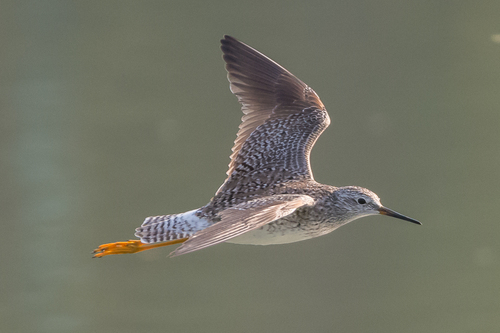
Lesser Yellowlegs
The Lesser Yellowlegs (*Tringa flavipes*) is a medium-sized shorebird known for its bright yellow legs and graceful foraging behavior. It plays an important role in wetland ecosystems, controlling insect populations and serving as an indicator species for habitat health. While not generally holding major cultural significance, it is a welcome sight for birdwatchers across the Americas, marking the changing seasons with its migrations.
23-28 cm
Length
59-64 cm
Wingspan
Least Concern
Conservation Status
Distribution
Breeds across North America, from Alaska and Canada south to the northern United States. Winters in the southern United States, Mexico, Central America, the Caribbean, and South America, as far south as Tierra del Fuego. Migrates through much of North and South America.
Lifespan
Average lifespan in the wild is not well-documented, but likely around 7-9 years, potentially longer.
Lesser Yellowlegs's Habitat
Habitat Types
Freshwater marshes, Shallow lake edges, Mudflats, Coastal saltmarshes, Flooded fields, Ponds
Climate Zones
Boreal, Temperate, Subtropical, Tropical
Adaptations
Long legs and bill allow it to wade in deeper water and probe for prey in mud and shallow water. Its relatively small size allows it to exploit smaller, shallower wetlands than larger shorebirds.
Variations
No recognized subspecies.
Appearance
Breeding Plumage
Breeding plumage is characterized by a mottled brown and gray back, a streaked neck and breast, and white underparts. Non-breeding plumage is plainer, with a grayer back and less streaking on the breast.
Seasonal Feather Changes
Significant changes between breeding and non-breeding plumage, as described above.
Sex Based Plumage Differences
Minimal sexual dimorphism in plumage; males and females are very similar in appearance.
Notable Features
Bright yellow legs, Straight, thin, dark bill, White eyering
Diet and Feeding
Primary Foods
Insects, Small crustaceans, Small fish, Snails, Marine worms
Foraging Behavior
Forages actively by walking or running in shallow water or on mudflats, probing with its bill or picking prey from the surface. Sometimes uses foot-stirring to flush out prey.
Specializations
The long, slender bill is adapted for probing in mud and water to capture a variety of small invertebrates.
Seasonal Diet Variations
Diet varies depending on prey availability. During migration and winter, may consume more crustaceans and marine invertebrates.
Behavior
Social Structure
Generally found in small flocks during migration and winter. Can be found in larger aggregations at particularly rich feeding sites. Territorial during breeding season.
Communication
A clear, ringing 'tu-tu-tu' call, A faster, more urgent 'kip-kip-kip' alarm call, Soft, peeping calls between parents and chicks
Migration
Long-distance migrant, traveling thousands of kilometers between breeding and wintering grounds. Migrates in flocks, often following coastlines or major river systems.
Territorial or Group Behaviors
Defends nesting territories during the breeding season. Outside of breeding, it is generally not territorial, though may defend small feeding areas.
Conservation
Threats
Habitat loss and degradation (wetlands), Pollution, Climate change (sea level rise, altered precipitation patterns), Human disturbance
Protection Programs
Migratory Bird Treaty Act (in the US and Canada), Wetlands conservation initiatives (various organizations and government agencies), International agreements for shorebird conservation
Local National Laws
Protected under the Migratory Bird Treaty Act in the United States and similar legislation in Canada and Mexico.
Population Trend
Stable
Population Estimates
Estimated global population is around 600,000 individuals.
Interesting Facts
They are often seen with Greater Yellowlegs.
The two species are often confused, but Lesser Yellowlegs are smaller, with a proportionately shorter and straighter bill.
They can swim if needed.
Although primarily a wading bird, they can swim short distances, particularly as chicks.
They are known for their energetic foraging behavior.
They often run after prey, unlike some other shorebirds that forage more deliberately.
Faqs about Lesser Yellowlegs
How can I tell a Lesser Yellowlegs from a Greater Yellowlegs?
Look at the size and bill. Lesser Yellowlegs are smaller, with a bill that is about the same length as the head and straight. Greater Yellowlegs are larger, with a bill that is noticeably longer than the head and slightly upturned.
Where can I see Lesser Yellowlegs?
Look for them in shallow wetlands, mudflats, and along the edges of ponds and lakes, especially during migration. Check local birding reports for recent sightings.
What do they eat?
They eat a variety of small invertebrates, including insects, crustaceans, and worms, which they find by probing in mud and shallow water.
Are Lesser Yellowlegs endangered?
No, they are currently listed as a species of Least Concern by the IUCN. However, their populations are dependent on healthy wetland habitats, which are under threat in many areas.
Copyright @ Nature Style Limited. All Rights Reserved.
 English
English